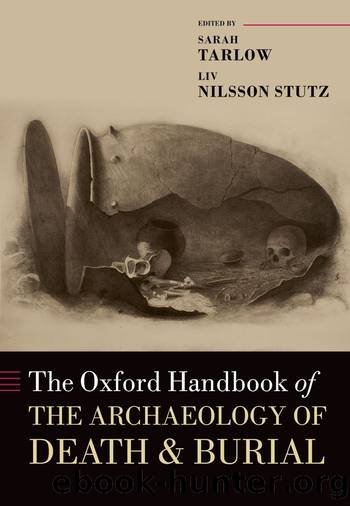The Oxford Handbook of the Archaeology of Death and Burial by Sarah Tarlow;Liv Nilsson Stutz; & Liv Nilsson Stutz

Author:Sarah Tarlow;Liv Nilsson Stutz; & Liv Nilsson Stutz
Language: eng
Format: epub
Publisher: OUP Premium
Published: 2013-02-14T16:00:00+00:00
CONCLUSIONS
This chapter has considered a number of aspects associated with the placement of northwest European megalithic tombs with respect to their cultural and natural landscapes. While it would be naive to assume that the same set of principles, beliefs, and ideologies operated among all the north-west European Neolithic communities inhabiting the vast area from the Atlantic to the Baltic shores, there are nevertheless a number of general similarities.
While the idea of a direct transfer of beliefs and ideologies between communities living in coastal areas that are familiar to us from ethnographic accountsâfor example the very rich cosmologies of coastal communities in North America or those of northern Europe and Siberiaâis inappropriate, such ideologies nevertheless help foster a better general understanding of the sets of beliefs which may have been associated with such landscapes in the Neolithic. The transitional nature and the liminal position of coastlines, as meeting places of different worlds in which humans, animals, and spirits encountered one another, may have been highly relevant and the placement of early monuments, burial tombs as well as standing stones, at such locations is highly significant. This is particularly relevant along the coasts of Neolithic Brittany as well as in southern Scandinavia where monuments were located close to the shore.
Thus, while in those regions the placement of monuments in relation to the sea was undoubtedly important, away from the coastâwhere the sea was too far away to be regarded as an important landmarkâother topographical features such as broad river valleys, moraine ridges, and flat plains provided landmarks which were imbued with cosmological significance.
In both coastal and inland locations across north-west Europe, megaliths appear to have been closely associated with the movement of people, both for practical and for symbolic reasons. They define a cultural landscape in which random scatters, variations between clustered and dispersed distributions, conveyed a wide range of meanings, from cultural liminality of the abodes for the dead to the signalling of ancestral presence to strangers. The fact that so many megaliths are found along later communication routesâboth overland and coastalâsupports the idea that they also played a role in the overall network of contacts and communication between different regions. While such networks were important in the provision of daily necessities as well as luxuries, above all they express the multidimensional world of the Neolithic farmers in which natural and cultural notions and beliefs about the past, present, and future were given tangible expression through the placement of megaliths.
Download
This site does not store any files on its server. We only index and link to content provided by other sites. Please contact the content providers to delete copyright contents if any and email us, we'll remove relevant links or contents immediately.
| Anthropology | Archaeology |
| Philosophy | Politics & Government |
| Social Sciences | Sociology |
| Women's Studies |
Mysteries by Colin Wilson(2885)
People of the Earth: An Introduction to World Prehistory by Dr. Brian Fagan & Nadia Durrani(2346)
Ancient Worlds by Michael Scott(2103)
Foreign Devils on the Silk Road: The Search for the Lost Treasures of Central Asia by Peter Hopkirk(2056)
The Memory Code by Lynne Kelly(1945)
Lost Technologies of Ancient Egypt by Christopher Dunn(1798)
The Splendid and the Vile by Erik Larson(1782)
Come, Tell Me How You Live by Mallowan Agatha Christie(1768)
The Earth Chronicles Handbook by Zecharia Sitchin(1744)
The Plantagenets by Dan Jones(1616)
Last Chance to See by Douglas Adams(1599)
The Return of the Gods by Erich von Daniken(1573)
Wars of the Anunnaki by Chris H. Hardy(1392)
Before the Dawn by Nicholas Wade(1316)
Keeper of Genesis by Graham Hancock(1280)
The Cygnus Mystery by Andrew Collins(1258)
The Message of the Sphinx by Graham Hancock(1223)
Fragile Lives by Stephen Westaby(1116)
Hieroglyphs: A Very Short Introduction by Penelope Wilson(1035)
